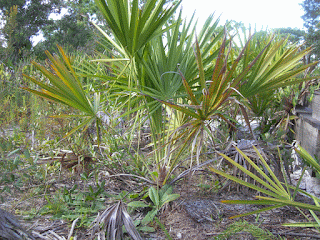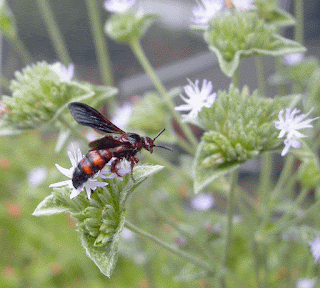Florida Elephant's Foot - Individual Florets at Bottom Right
The foliage is much grayer and hairier than depicted.
Unspectacular, even slightly ungainly, Florida elephant's foot belongs to that class of plants delightful mainly to the observant eye, for it easily gets lost in a crowd. A flat rosette of coarse leaves wider at the tips than at their bases sends up grayish, wiry branching stalks which can reach up to 3 feet tall according to the books. Mine are closer to 18-24 inches. Each branchlet (in botany language a pedicel) ends in a pyramidal structure composed of 3 overlapping bracts packed with individual disk florets. Florets are a delicate pale lavender-pink. The florets in any given head open somewhat sequentially, not all at once, so the effect is subtle, hardly spectacular.
 |
| Florida Elephant's Foot - Habit |
The gray-green clusters and delicate florets seeming to hover untethered over lower-growing plants, or among grasses, give the scene a wonderfully airy and ephemeral effect. My plant is being supported by the grassy leaves of spiderwort ( Tradescantia ohiensis). Spiderwort isn't native to this part of Florida, but does pretty well - in fact, too well at times. I will have to thin this batch to keep it from overshadowing and outcompeting the elephant's foot. I suppose elephant's foot would have to be staked in a more formal garden, but loosely, so as not to destroy its peculiar charm.
There are 4 species of Elephantopus native to Florida, but elatus, the "tall elephant's foot," is the only one that occurs in SW Florida. This species is found in throughout most of Florida and parts of Louisiana, Mississippi, Alabama, Georgia and South Carolina. In Florida its status is "Threatened." It can take rather dry to reasonably moist situations, and is commonly found in pine flatwoods.The Florida Native Plant Society lists it as a "short-lived perennial."
Though it is quite drought-hardy, and used to sandy soils, I find that the plant does better in our hot yard with a little moisture and shade. I don't need to water it in its present place where it gets runoff from the eaves and protection from the afternoon sun, but the ones I planted elsewhere, in full unabated sunlight, died out.
 |
A Head and Ray Florets (I've rotated this photo several times and still can't figure out which end is up) |
Over time, Florida elephant's foot will form clumps, like many plants in the Aster Family. It also grows from seed. In our yard it goes dormant in the dry season, disappearing entirely until the rains resume.
Though it works wonderfully blended with other plants, a large plot of Elephantopus alone in bloom is quite and quietly spectacular. When he was still in high school my much younger brother tilled up a section near the woods to grow corn. The raccoons got most of the corn, but there obviously was a dormant seedbank for elephant's foot, because it flourished in that spot thereafter. More than 40-50 years later, there are still scattered plants there in spite of repeated disturbance. In fact, the plant in our yard is a descendent of these north-Florida individuals.
 |
Colony of Elephant's Foot under Serenoa repens Naples Preserve |
Florida elephant's foot doesn't seem overly attractive to butterflies, but is very popular with wasps and bees. The photo below shows what I believe to be a spider wasp nectaring. Spider wasps paralyze spiders and inter them as food for their larvae. They can manipulate a spider far larger than they are themselves. Though they can sting, they usually aren't aggressive. This one didn't mind my getting up close.
Florida elephant's foot is so named because from overhead, the outline of the basal rosette supposedly resembles the footprint of an elephant. That takes some imagination. For one thing, the elephant would have to have toes all around its foot, not just in the front.
A garden full of divas would be pretty jarring and incoherent. It needs a complement of modest and unassuming plants like Florida elephant's foot to furnish the backdrop so the stars can shine.


